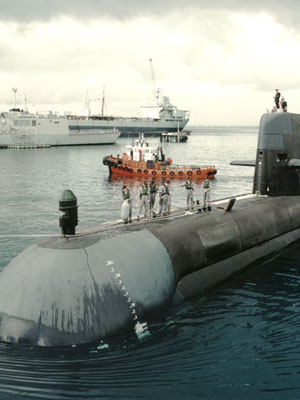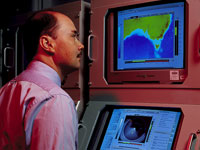Collins Class Replacement Technologies

In the mid-1980s, the Australian government decided to replace existing Oberon submarines with six Collins Class Type 471 diesel-electric submarines.
Designed by Swedish shipbuilders Kockums for the Royal Australian Navy (RAN), the submarines were totally designed by computer, and powered by banks of lead-free batteries that are charged by three on-board diesel generators.
DSTO (now DST Group) played a highly significant role in the ‘get well’ and ‘fast track’ programs for the Collins Class submarines during the construction phase from 1993 to 2003. This research has been a major factor in developing the most advanced non-nuclear submarines in the world. Over the last two decades, Defence scientists have assisted with several key developments.
Noise reduction
Dr Chris Norwood and his team significantly reduced the noise or acoustic signature generated by submarines during operations at depth and while snorting (the process of running the diesel engines and recharging the batteries).
Signature reduction
Dr David Oldfield and his team developed specialised anechoic tiles for the Collins class submarine for signature reduction. Designed specifically for use in warmer waters, the tiles are the acoustic equivalent to camouflage patterns, forming an anechoic coating that reduces the risk of sonar detection.
High-strength steel and welds
Dr John Ritter and his team developed a new high-strength steel for the Collins class submarine and advanced welding technology to match, saving Australian industry $17 million. Dr Ritter’s collaboration with the RAN’s Submarine Project Office, the designer Kockums AB in Sweden, the builder Australian Submarine Corporation, and steel producers BHP and Bisalloy Steels, resulted in the acceptance of a fracture control methodology which ensured that optimum resistance to shock loading was built into the new submarines. It also meant that Australian industry was able to perform all steelwork maintenance and repair work for the Collins Class submarine. The innovations of steel and welding technology were at the forefront of submarine steel technology worldwide.
Combat system

Dr Todd Mansell assisted the RAN and the Defence Materiel Organisation (DMO) in the acquisition and replacement of the combat system for the Collins class submarine.
Defence scientists continue to provide expert technical advice on the Collins Class submarine combat systems, researching novel combat system concepts and studying the interaction between systems and operators.
Shock trials
The Collins Class submarine shock trials were the first to be conducted in Australia on a commissioned submarine. DST received wide and very positive acknowledgments from the RAN and the Australian Submarine Corporation for its efforts and achievements.
Failure mechanisms for hoses
Defence scientists investigated the failure mechanisms for hoses on Collins class submarines. The team identified the most likely failure mode and the chain of events after failure. This work received positive feedback from the Submarine Force Element Group, DMO, and Parliament.
Batteries
Lead-acid batteries have been used as an energy source for submarines since the late 1800s. While these storage devices had proven quite robust in submarine applications, there were problems. Defence scientists have been involved in assessing and improving the performance of the twin-cell lead-acid batteries of the Collins Class submarines by developing sensors and charging systems.
Closed Loop Degaussing System
The Closed Loop Degaussing System was developed by Defence scientists in Sydney for the Collins class submarine. The system was designed to counter the effects of stress magnetisation changes in the pressure hull.
Kariwara slim-line towed array
Designed and developed by DSTO and later fitted to the Collins class submarines.
See our Towed Arrays page for more.
Submarine Acoustic Transitory Event Processing System (SATEPS)
SATEPS is an enhancement of the Ping Intercept Passive Ranging System (PIPRS). Developed by Defence scientists in Sydney, the PIPRS prototype was able to determine the range of active acoustic transmissions used to locate possible targets in anti-submarine warfare. The SATEPS was deployed in the Collins class submarines.
V18 Hedemora Diesel Engine
Defence researchers conducted system and component redesign of the turbo-charged V18 Swedish-designed Hedemora Diesel engines fitted on the Collins Class submarines, in order to make the engines more suited to Australian conditions. Conditions experienced in heavy seas off the Australian coastline were found to produce greater additional stress on the engines. To reduce the occurrence of component failure, Defence scientists also addressed issues associated with cylinder over-pressures, tortional and lateral vibration, and fuel purity. Additionally, researchers carried out studies on the Hedemora engines to identify maintenance optimisation techniques to reduce operational costs while maintaining and possibly increasing platform reliability and availability.
Sonar
DST Group’s Submarine Sonar group conducts research on concepts and systems that have the potential to significantly improve Collins Class submarine sonar performance. The Sonar Processing Laboratory is the main facility for submarine hull and towed sonar data replay and analysis. It is currently the only Australian Defence organisation laboratory where data collected by Acoustic Data Replay Units fitted on Collins Class submarines can be replayed for analysis of submarine operations. This data is critical to evaluating hull sonar performance and investigating advanced processing concepts.
Sonar wet-end diagnostic system
Assisted by Dstl and QinetiQ of the UK, within four months DST developed a sonar wet-end diagnostic system called Wet Nurse that enables defective sonar array sensors to be identified and remedial action taken at sea. Following trials, the system was recommended for inclusion on all Collins Class submarines
Hull damage
DST developed a new method to assess hull damage that could be caused by a torpedo.
Flare trajectory
DST undertook studies of the trajectory of flares and markers launched from a submarine’s submerged signal ejectors and the likelihood of their re-contact with the boats.
Air quality
Defence scientists developed an exhaled breath analysis technique to determine submariners’ exposure to particular contaminants in sealed environments without access to fresh air. Similar to police breath-testing, the technique is able to measure absorption through the lungs and skin and has been used with excellent results in the Collins Class submarine. The technology is not only expected to result in a safer working environment but also extend the operational capability of the submarines.
Smoke modelling
Defence researchers developed a unique smoke modelling facility to simulate the spread and clearance of smoke in the Collins Class submarine. Because conducting tests on a real Collins Class submarine would have proven too difficult and far too costly, a 1/15th scale clear plastic model of the submarine fitted with scale versions of the living quarters, electrical cabinets, machinery, torpedoes and air conditioning system was designed and constructed by Boeing Australia. This model was then used to simulate the outbreak of fires in various locations throughout the submarine.
Using salt water modelling, the transparent model was filled with fresh water, representing the air within the submarine and coloured salt water, representing the smoke produced by a fire. The movement of the salt water through the model mimicked the movement of hot smoke through the submarine allowing scientists to contribute valuable data to the performance, safety and survivability of the Collins Class submarine and crew.
Improving submarine technology
In 2005, DST and ASC Pty Ltd signed a three-year industry alliance agreement to improve submarine-related technology and innovation. This alliance will initially focus on technology innovations in the areas of noise and vibration, hull and structural integrity, enabling technologies, asset management and systems sciences, including systems and sensor integration for the Collins Class submarines. While the submarines are widely considered at the forefront of defence science technology, ASC’s industry alliance with DST will ensure ongoing expert, impartial and innovative application of science and technology (S&T) to ensure the Collins Class remains the best conventional submarines in the world.

